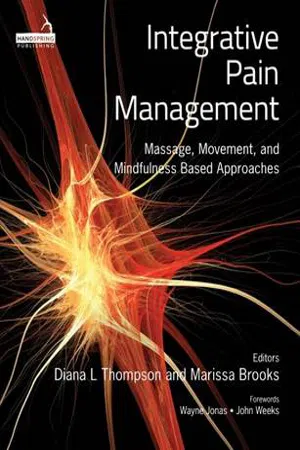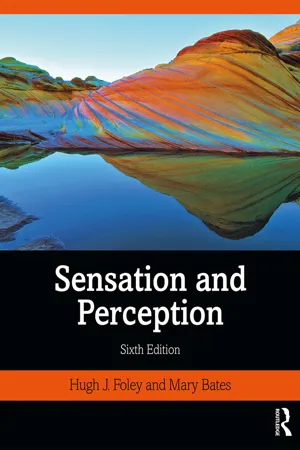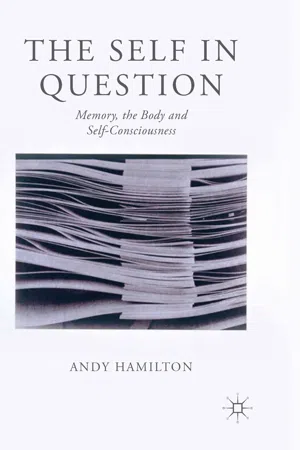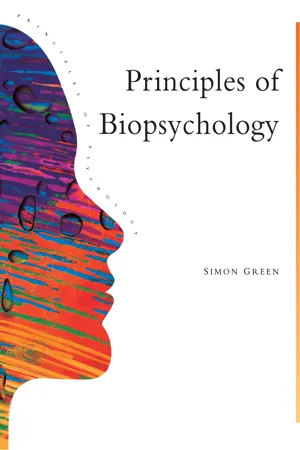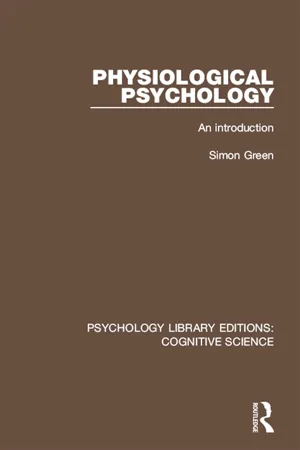Body Senses
Body senses refer to the various sensory systems in the body that provide information about the external environment and the body's internal state. These include the somatosensory system, which processes touch, temperature, and pain, as well as the vestibular and proprioceptive systems, which contribute to our sense of balance and body position. These senses play a crucial role in our perception and interaction with the world.
7 Key excerpts on "Body Senses"
- eBook - ePub
- Diana L. Thompson, Marissa Brooks(Authors)
- 2016(Publication Date)
- Handspring Publishing(Publisher)
...2009). We define body awareness as sensory awareness that originates from the body’s physiological state, involving interactive processes (including pain and emotion), actions (including movement), and appraisal (as well as complex bottom-up and top-down neural activities) shaped by the person’s attitudes, beliefs, and experience in their social and cultural context (Mehling et al. 2009). These top-down activities determine whether body awareness is maladaptive or beneficial. Neurophysiology of Pain as it Relates to Body Awareness From a neurophysiological viewpoint, body awareness includes both proprioception and interoception. Proprioception is the perception of joint angles and muscle tensions, of movement, posture, and balance. Interoception is the perception of all sensations from inside the body and includes the perception of physical sensations related to internal organ function such as heart beat, respiration, satiety, and the autonomic nervous system symptoms related to emotions (Vaitl 1996; Cameron 2001; Craig 2002; Barrett et al. 2004). Many of these perceptions remain unconscious; what becomes conscious enters proprioceptive and interoceptive awareness, which involves higher mental processes such as emotions, memories, attitudes, beliefs, and behavior (Cameron 2001). Neuroscience has revealed how and in which areas of the brain interoception is processed and how it relates to emotion and pain (Bechara and Naqvi 2004; Critchley et al. 2004; Wiens 2005; Naqvi, Shiv, and Bechara 2006). In this chapter, however, we will emphasize the first-person phenomenology of massage and body therapy experiences, an area that is of yet not within the purview of current brain science. Pain, particularly chronic pain, is a highly complex subjective experience with sensory discriminative, affective, and behavioral aspects, and distinguishable neural pathways for each. The last decades have provided important new insight into pain and the ways it is neurologically processed...
- eBook - ePub
- Hugh Foley, Margaret Matlin(Authors)
- 2015(Publication Date)
- Psychology Press(Publisher)
...Chapter 12 The Skin Senses The Skin Receptors in the Skin From the Skin to the Brain Touch Afferent Systems for Touch Passive Touch Active Touch Interactions between Touch and Vision Temperature Afferent Systems for Temperature Thresholds for Temperature Adapting to Temperature Pain Afferent Systems for Pain and Gate-Control Theory • IN DEPTH: Phantom Limbs and Pain Measuring Pain Adapting to Pain Controlling Pain Kinesthetic and Vestibular Senses Kinesthetic Sense Vestibular Sense IN ELEMENTARY SCHOOL, your teacher might have told you about the five senses: vision, hearing, touch, smell, and taste. Aristotle used this classification system more than 2,300 years ago, and it is probably still the most common one. However, it’s clear that we rely on more than five senses. In this chapter, we’ll explore a set of senses embedded in our bodies, collectively called the somatosensory system (from the Latin and Greek soma meaning “body”). The somatosensory system has three separate systems that interact with one another (Pinel, 2006). We’ll ignore one system, which monitors your body’s internal states. We’ll focus primarily on another system, which interprets the impact of the outside world on your body. This system provides you with touch, temperature perception, and pain perception. Finally, we’ll consider the system that informs you about whether you are standing upright or tilted and where your body parts are in relation to each other. That somatosensory system is augmented by information from the vestibular system of the inner ear, which we first mentioned in Chapter 9. The Skin Your skin represents the largest sensory system you own, with a surface area of about 2 square yards in adults (Weisenberger, 2001). Contrast this size with the relatively minuscule receptive surfaces for vision and hearing. In spite of the size advantage of your skin senses, both vision and hearing may seem more important to you...
- eBook - ePub
- Hugh J. Foley(Author)
- 2019(Publication Date)
- Routledge(Publisher)
...Chapter 12 The Skin Senses The Skin Receptors in the Skin From the Skin to the Brain Touch Afferent Systems for Touch Passive Touch Active Touch Interactions between Touch and Other Senses Temperature Afferent Systems for Temperature Thresholds for Temperature Adapting to Temperature Pain Afferent Systems for Pain and Gate-Control Theory ● IN-DEPTH: Phantom Limbs and Pain Measuring Pain Adapting to Pain Controlling Pain Kinesthetic and Vestibular Senses Kinesthetic Sense Vestibular Sense I n elementary school, your teacher might have told you about the five senses: vision, hearing, touch, smell, and taste. Aristotle used this classification system more than 2300 years ago, and it is probably still the most common one. However, it’s clear that we rely on more than five senses. In this chapter, we’ll explore a set of senses embedded in our bodies, collectively called the somatosensory system (from the Latin and Greek soma meaning “body”). The somatosensory system has three separate systems that interact with one another (Pinel, 2006). We’ll ignore one system, which monitors your body’s internal states. We’ll focus primarily on another system, which interprets the impact of the outside world on your body. This system provides you with touch, temperature perception, and pain perception. Finally, we’ll consider the system that informs you about whether you are standing upright or tilted and where your body parts are in relation to each other. That somatosensory system is augmented by information from the vestibular system of the inner ear, which we first mentioned in Chapter 9. The Skin Your skin represents the largest sensory system you own, with a surface area of about 2 square yards in adults (Weisenberger, 2001). Contrast this size with the relatively minuscule receptive surfaces for vision and hearing. In spite of the size advantage of your skin senses, both vision and hearing may seem more important to you...
- eBook - ePub
The Self in Question
Memory, The Body and Self-Consciousness
- Andy Hamilton(Author)
- 2013(Publication Date)
- Palgrave Macmillan(Publisher)
...4 Proprioception and Self-Consciousness (1): Proprioception as Direct, Immediate Knowledge of the Body We now turn from memory to proprioception. This chapter and the following one apply the same treatment to proprioception and bodily identity, involving conceptual holism, as that applied to memory and personal identity. The faculty or capacity of proprioception is both familiar – because it underlies the possibility of action – yet mysterious. It yields ordinary knowledge of bodily position and movement – what is loosely termed “bodily awareness”. Yet in Philosophy it has until quite recently been neglected; indeed, in my experience the issues it raises remain unfamiliar to general philosophical audiences. Hence a rather fuller account of the nature of proprioception is required than in the case of memory. This chapter aims to demystify proprioception by considering both Phenomenological and Gibsonian accounts. There is important common ground between Gibson’s position and that of Phenomenology, both influenced by Gestalt psychology, and a philosophical treatment of the body and self-consciousness should draw on each. The varieties of proprioception are complex. The core capacity yields knowledge of bodily position and movement. Strictly speaking, kinaesthesis, often used as equivalent to proprioception, is knowledge of movement of parts of the body, as opposed to their posture or position. 1 Other varieties of proprioception include knowledge of fatigue and warmth and cold (as opposed to merely feeling tired, hot, or cold); the inner ear’s vestibular system that gives information about balance and posture; interoception (the visceral sense); and “visual proprioception”, the term coined by J. J...
- eBook - ePub
- Simon Greene(Author)
- 2013(Publication Date)
- Psychology Press(Publisher)
...I will briefly review the somatic senses, proprioception, smell and taste, and then deal with pain perception in more detail. Most of the chapter will concern hearing as this, along with vision, is the system on which we rely most. Somatic Senses If you imagine the range of stimuli you can feel on your skin, then you are imagining the range of our somatic senses. Some seem to be related—light touch, pressure, tickling etc—and some seem very different—pain, heat and cold. Those related to touch involve mechanical pressure on the skin. This produces movement of the skin surface, and this is picked up by sensory receptors beneath the surface. Changes in skin temperature are also sensed by specialised receptors. The perception of pain can be produced by all sorts of stimuli, as it depends in part on stimulus intensity rather than type; pinching, jabs with a sharp instrument, extreme heat or cold, can all lead to a feeling of pain along with the sensation of being hit or of being hot or cold. Buried under the skin in the epidermis and around the base of body hairs are a number of different types of sensory receptor. The simplest are free nerve endings which, as their name implies, are barely modified axons. They respond particularly to heat and cold. Pacinian corpuscles seem particularly sensitive to vibratory stimuli on the skin, but for other specialised receptors, such as Meissner corpuscles and Krause endbulbs, no clear specialisation has been found. In fact there is something of a paradox here. There are hundreds of receptors in every square millimetre of the body surface, although some parts, such as the hands, are better served than others. There are a number of different receptor types, and we are responsive to a wide range of stimuli, but it does not appear that the receptors are stimulus-specific...
- eBook - ePub
Physiological Psychology
An Introduction
- Simon Green(Author)
- 2016(Publication Date)
- Routledge(Publisher)
...The relevant receptors include various of the touch mechanoreceptors already mentioned, located in and around limb joints. Awareness of limb movement (kinaesthesia) also involves receptors located on muscle fibres sensitive to muscle stretch. Proprioceptive sensory input enters the central nervous system along the somatosensory tactile pathway, via the spinal dorsal column, medial lemniscus, thalamus, and finally the post-central somatosensory cortex. A vital contribution to proprioception is made by the vestibular apparatus, located in the inner ear. This organ is crucial to the sense of balance. In outline terms it consists of three semicircular canals and the otolith organs. These structures are continuous with each other, but arranged in space so as to cover all possible orientations – the semicircular canals lie perpendicular to each other. The whole arrangement is fluid-filled, and displacement of the fluid, produced by movement of the head in any direction, is picked up by specialized hair cell receptors and converted into afferent sensory impulses along the eighth cranial nerve (p.28). After a synapse in the brainstem, information travels to parts of the cerebellum, which are in turn connected to eye muscles and descending motor pathways to the spinal cord. The system controls body balance and the coordination of head and body movements. (For a more detailed discussion of proprioception and other material covered in this chapter, see, e.g. Kandel and Schwartz, 1985.) Taste The sensation of taste depends upon a molecular combination between the substance and a taste receptor. The receptors themselves are modified skin cells, and occur in groups of around fifty on a taste bud. The taste buds are found clustered in small numbers in papillae, folds in the surface of the tongue...
- Kieron P. O'Connor(Author)
- 2015(Publication Date)
- Routledge(Publisher)
...‘When I’m driving my car becomes my body. It’s like I extend to the doors, even the mirrors; I kind of bend with it. When someone cuts me off it’s like their pushing me, not my car’. Embodied emotion Our sense of body can be traced to proprioception, which Sherrington considered a prime function. As far back as 1900 Sherrington showed that there is never any pure exteroceptive reflex that depends only on the intervention of an external stimulus. Sherrington (1900) proposed that all reflexes require proprioceptive feedback of the context or biological value of a stimulus to be effective, and the fate of an excitation is determined by its relationship to the whole of the organic state and to preceding and simultaneous excitations. In other words, the concurrence of a multitude of conditions in the organism has as much right as the stimulus to be called the cause of the reaction. Earlier ideas considered the body and emotions controlled by somatic signals coming from the brain. But this semantic network idea of modular mental nodes controlling emotion has recently been replaced by ideas of embodied emotion. The idea that body activity is closely allied with thought is hardly new. As Lakoff and Johnson (1980) have pointed out frequently, even language uses action metaphors to convey emotion. Metaphors involve action to simulate an emotion, ‘love’s a journey’, ‘life’s a struggle’, etc. Berlin et al. (1991) note metaphors can create meaning by forging similarities. Lakoff and Johnson called metaphors derived from experience with the body ‘the body in the mind’. Somatically based imagery takes metaphorical projections from physical processes and applies them to conceptual/rational elements. The notion of ‘balance’ and ‘weight’, when applied to arguments, is a good example. Lakoff and Johnson argue that all cognition is based on knowledge that comes from the body through conceptual metaphor, image, schemata and prototype...
